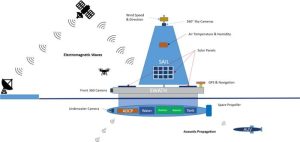The rapid melting of ice in the Arctic has caused serious concern in the scientific community due to the pace of increased thinning.
Additionally, sea ice thicknesses have also decreased, making Arctic ice covers more vulnerable to warming air and ocean temperatures.
It is important to understand the ecological role of Arctic sea ice, especially as local ice ranges are decreasing at unprecedented rates.
To do this, researchers at the University of Engineering and Computer Science at Florida Atlantic University proposed the design of alternative autonomous observation methods.
This method promises to improve the autonomy of marine vehicles, support maritime missions, and provide a deeper understanding of how melting of Arctic ice affects marine ecosystems.
Autonomous methods preserve stability in the Arctic conditions
Traditional Arctic ice observation methods provide limited temporal and spatial coverage, but drones and autonomous underwater vehicles (AUVs) are hampered by energy constraints that limit the possibilities of research .
This conceptual design features small waterplane area twin hull (swath) containers that act as docking and charging stations for AUVS and unmanned aerial vehicles (UAVs).
The Swath Ship is designed for extraordinary stability and can survive the melting of Arctic ice and operate in a wide range of ocean conditions.
Designed to be self-sufficient, it utilizes automated sailing, solar panels, and underwater turbines located between twin hulls to generate and store energy, allowing for continuous voyages against ocean currents. We will ensure mission support.

©Florida Atlantic University
Unlike previous platforms, the system designed by FAU researchers uses advanced technology to monitor the Arctic Ocean from the air, water surface and underwater.
The new unmanned surface vehicle (USV) design has been specially tuned for the project to ensure stability in Arctic conditions and handle strong wind speeds.
The main purpose of the observation platform system is to investigate the melting of Arctic ice in rapidly changing regions. Wind energy is utilized to facilitate voyages in Arctic waters, but underwater turbines produce enough energy to keep the system operating.
Long-term Arctic ice monitoring
The results show that using wind-driven yacht movements to generate electricity from turbines under the band is a viable way to support long-term Arctic ocean monitoring missions .
The design will be integrated with the monitoring environment and will provide new data on Arctic ice melting beyond what satellites and manned ships can offer.
“Our proposed autonomous observation platform system provides a comprehensive approach to studying the Arctic environment and monitoring the impact of sea ice melting,” said FAU’s Department of Marine and Mechanical Engineering. says Tsung-Chow Su, senior author and professor.
“By providing an independent platform for ongoing data collection, this design supports scientific research, environmental conservation and resource management, laying the foundation for annual Arctic surveillance.”
Stella Batalama, dean of the FAU University of Engineering and Computer Science, added: “Our researchers have developed innovative observation systems tailored to the Arctic environment, providing important data on sea ice melting, and providing important data on the inability of satellites and manned ships to capture.
“Long-term surveillance is essential as it provides deeper insight into the lasting impact of Arctic ice melting.
Source link

